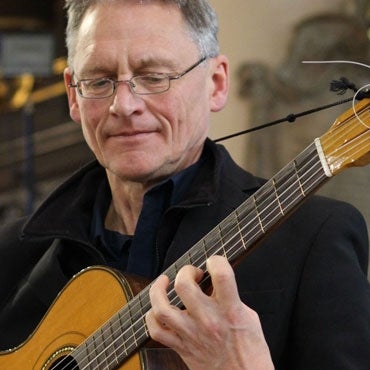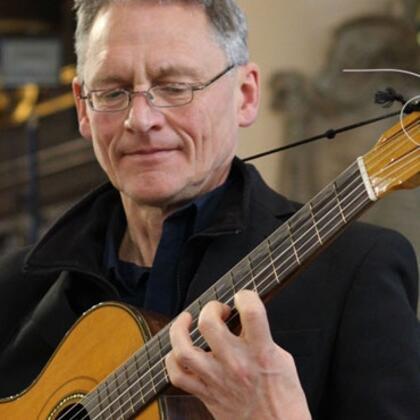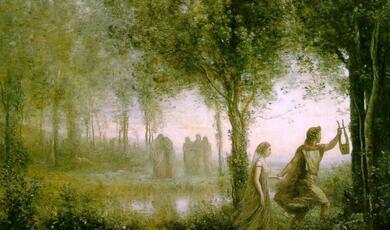Being a Guitarist in the Time of Byron and Shelley
Share
- Details
- Text
- Audio
- Downloads
- Extra Reading
With a player’s insight (a guitar of 1825 is my main instrument) this lecture explores the experience of the Regency guitarist: the day-to day business of buying and learning the instrument for the purposes of cutting a figure as a salon amateur or indeed as a professional (to the extent that such a career was feasible – an issue to be explored). It will consider the availability of sheet-music with arrangements of opera favourites, the rise of the governess guitar teacher, the struggle of enthusiasts to cope with contemporary prejudices against the guitar, and the miseries of slipping pegs, breaking strings and damp. The role of the newspapers in advertising instruments, concerts and new music will be an underlying theme of this and several other lectures in the series.
The lecture by Professor Page was illustrated by performances by Ulrich Wedemeier of the following pieces:
Fernando Sor: Que ne suis-je la fougère!, Opus 26 (extract)
Fernando Sor: Minuet from Opus 15.
John Abraham Nuske: Fantasia (extract)
Fernando Sor: The Fantasie élégiaque, Opus 59 (extract)
Below is one of the Performances from the Lecture.
Download Text
20 November 2014
Being a Guitarist in the Time of Byron and Shelley
Professor Christopher Page
It is a warm summer night in 1815, and the guitarist Fernando Sor is making his way up the grand staircase of Carlton House, a royal residence, long since demolished, in the heart of London’s West End. You have a picture of Sor on the first page of your handout. It is all very strange to him, for Sor is a native of Catalonia who has recently arrived from France. As he mounts the stairs, Sor speaks in his broken and ungrammatical English to the footman who guides him, and begins to prepare himself for the short recital he is due to give before the royalty and nobility of England. As he passes the main room where he is to perform, Sor has a brief glimpse, through an open door, of the audience gathered within. To speak of the room first, it is the concert hall of his nightmares; packed with people, it is decorated with opulent curtains, fabric-covered sofas and rich carpets that will absorb and swallow up the sound of his discreet instrument. As for the audience, many of the men present are in their regimental uniforms, providing a sharp reminder that the final conflict with Napoleon, on the field of Waterloo, is imminent, and that many of those present will soon be departing for the battlefield.
Once the footman has explained the etiquette he will need to observe when playing before royalty, Sor attends to his instrument, the source of any fortune he is to have in this city as yet mostly unknown to him. He opens the case, so that his guitar and its strings of gut will slowly become acclimatized to the atmosphere of the rooms. Since it is summer, the presence of so many people has created a very close, even a damp, atmosphere throughout the building. Sor takes out his guitar, and now we have a glimpse of it. The body is smaller than that its modern descendant, and there are none of the metal gears, or tuning machines, that ease the process, for a modern player, of making fine adjustments to the tuning. Slowly and carefully, Sor turns the pegs to tune the instrument.
He knows that the performance will be an uphill struggle. To be sure, the guitar is by no means unknown in England at this date. Lord Byron’s Childe Harold, the literary sensation of the age, is still in the process of publication, and everyone knows the passage in Book I where Spain, personified as a woman suffering under Napoleon, ‘Hangs on the willow her unstrung guitar’ and turns to battle. What is more, Princess Charlotte of Wales is a keen guitarist, and some of the best professionals in London have dedicated music to her and at least one published tutor. But as Sor prepares to walk out before the audience, he wonders what men and women of the nobility and gentry will make of his soft-voiced guitar. So…walking out before the royal family and the court he bows, sits and begins:
Fernando Sor: extract from Que ne suis-je la fougère!, Opus 26.
Lithograph of Fernando Sor (1778-1839) by Engelmann and Bordes, after Goubeau
In the first lecture I considered some broad themes and asked: what made the romantic guitar romantic. This time I want to explore how did the fashion for the guitar arose and what it was like to be a guitarist in the first decades of the nineteenth century in England. For the origins of the guitar craze, we should probably look back to the second half of the eighteenth century and to immigrants from Italy and France. The Italian community in later-eighteenth century London was large, and especially plentiful in the Cities of London and Westminster, as in the Borough of Southwark, where they traded as merchants, brokers, florists and keepers of Italian warehouses stocking imported goods from all over the Mediterranean: Bologna sausages, ‘new Provence and Spanish olives’, ‘fine new Parmesan’. A search through the annals of the theatre soon reveals characters such as Giovanni Battista Noferi, best known as a violinist and minor composer, who played his ‘inimitable Spanish guitar’ on stage in the 1770s; there was also Delphini, the pantomime actor at Drury Lane and elsewhere, who played the Spanish guitar. There were also French guitarists in London at this time, some of whom were undoubtedly refugees. For the period 1792-1802, the mean annual figure for French nationals leaving post-Revolutionary France for Britain has been put at about 12,500 persons with an estimated 25,000 crossing the Channel in 1792 alone. Some tried to prosper by teaching musical instruments; in the old Huguenot quarter of Soho, in King’s Street, Monsieur Grumaille advertised himself as a professor of the Spanish guitar in June 1789, and announced that he had a harp of the best Paris make and ‘an exceeding good Spanish guitar’ to sell. His presence in London suggests he may have decided to leave France in what he judged to be increasingly ominous times. On 9 October 1790 the newspaper World carried the advertisement of a Monsieur Prador, describing himself as ‘a Native of France…where he has always resided’, offering lessons on the harp, violin and Spanish guitar. ‘M. Prador’, runs the advertisement, ‘may, perhaps, be reproached with making a lucrative use of his talents; his motive, when known, will be his excuse’. The motive was perhaps that a flight from France had left him nearly penniless.
So if that is how it all began, what did it all come to? I would like you to look at an especially revealing image from the period; it comes from a satirical series Entitled Old Ways and New Ways, published in late 1829 or very early 1830:
The old way and new way of performing a concert. From a satirical series entitled Old Ways and New Ways (1829/30)
The differences are very revealing:
1. There are more women in the ‘new’ way, and there is something even amorous about the company in places (notice the man and woman on the right). Note also that the black attendant has vanished.
2. In the new way there is an emphasis upon children being made to display their talents.
3. For the men, the heavy wigs have been replaced by more flamboyant and dandyish hairstyles.
4. The music-stands, which are like small and rather crude easels in the old way, have been replaced by elegant furniture
5. The general tessitura of the music has risen: the bassoon has gone from the old way, and so has the cello.
6. There is much more light, plucked sound: the harp has been entered and so too the guitar (interestingly played by a dandyish male).
The emphasis is upon the fresh, the fashionable and the light: an age’s vision of itself. The print therefore says much about the appeal of the guitar which, as you can see, has been placed well forward. But the print also conceals a great deal, as satire is often inclined to do. Playing the guitar in the time of Byron and Shelley was a constant struggle against technical and indeed social adversity. For a start, a guitarist in the first three decades of the nineteenth century faced considerable hostility from a relatively new breed of newspaper music critic; these self-appointed arbiters of taste, very vociferous but relatively few in number, contributed to the emerging sense that a body of canonical and especially symphonic music was coming into being, notably as the symphonies of Beethoven became known. These works required larger and louder resources, in bigger concert halls and assembly rooms. In all this, the guitar went completely against the grain. It was a superb resource for accompanying the voice, as even its most trenchant critics were prepared to admit; but since it was too quiet to join anything larger than a small chamber ensemble, it was considered out of place in the concert halls of the nineteenth century (which made the life of professional performers difficult) but was ideal for the home. An expanding repertoire, generally for domestic consumption of waltzes, sets of variations and songs, was increasingly available in print. This all ran counter, and perhaps deliberately so, to the emergence of the symphonic masterworks. Where the symphonies were massive, predominantly instrumental, highbrow and public, the culture of the guitar was intimate, primarily vocal, middlebrow and intimate:
Fernando Sor, Minuet from Opus 15.
It was therefore extremely difficult to build a professional career as a player, or to give the guitar any real exposure in concert venues of the day. Public performances in concerts by guitarists were often roundly condemned, as in this review of a concert from 1836 in which the guitarist Signor Verini took part:
We arrived on Monday morning at Willis’s Rooms just in time to hear the Signor's fantasia on the Spanish guitar…The guitar is just calculated for…the smallest architectural construction that hath entered the mind of man to edify: but in a spacious concert room it is even worse than contemptible; it is irritating also, particularly if decently played; for one resents the time and pains that have been expended to attain even that decency of execution upon an ungrateful tingling box, not superior in tone to a child’s musical cart.
In addition to problems arising from the relative softness of their instrument, guitarist faced a welter of technical difficulties arising in part from the vagaries of wood, pegs and strings. Here is a review from The Sheffield Independent, March 15, 1834 (the player a Polish exile), copied form the original:
What were the ‘difficulties’ with which the player had to contend? One, which guitarists shared with all musicians in Britain, was cold. Think of London, Liverpool, Birmingham or Manchester with nothing but a coal fire to heat a room in even the richest houses. As Emily Shore wrote in her diary for one day May, 1835:
‘…I am horrified at the mischief done by the smoke {in London). Almost all the houses are blackened, the yards and back premises are covered with soot, the trunks of all the trees are black, all plants become dingy, clothes get tarnished by the smoke, the hands can hardly be kept clean, and in some winds great puffs of smoke enter the open windows’.
The result, in any room, was raw heat on the body near the fire and a progressively greater chill as one moved away from the hearth or as the embers faded for want of being tended. It is no surprise that a grimly comical book, entitled The Miseries of Human Life and published in 1810, identifies the misery of having to ‘to play on the pianoforte, while all your fingers are chained up by the frost’.
There was also the problem of damp. Sample any set of early photographs showing people, especially men, who were alive in the 1840s or 50s and you will probably see some with the lined and leathery complexion of those who walked in all weathers far more than we do, or who sometimes travelled in outside seats of coaches in the rain, wind and even the snow when nothing else was available. The rain ambushed riders in the countryside and forced them to lie in bed for two hours in a country inn while their clothes dried out; it doomed excursions and picnics – we shall hear something of that in a later lecture; for the guitarist, far more than the pianist, whose strings were of metal and safely locked away inside a big wooden box, the rain was a curse. We know far less about the gut strings musicians used in the early nineteenth century than we would wish, though scraps of them do survive in old cases or even complete on instruments that have been little touched for some hundred years. Desiccated and often filthy, they are now beginning to give up their secrets as they are subjected to scientific tests. What we have always known, however, is that humidity has a marked effect upon a gut string as it absorbs moisture in the air. Even the novelists of the day had cause to mention its effects, as in Caroline of Litchfield, published in 1786:
Caroline) sat down to her music; but the two days rain had put her harp and guitar out of tune, and she was obliged to lay them by; the piano forte was less affected, and she played an adagio, which but augmented melancholy.
As a result of cold and damp, things could go badly wrong in performance, especially with the tuning.Here is the review of a concert given at the Bull Inn Assembly Room, Preston, on July 26, 1834:
Notice the cutting understatement, a favorite device of the newspaper reviewers: ‘his guitar was somewhat of out tune in his accompaniments’. Perhaps this Mr Fitzwilliam was unlucky enough to have one of his tuning pegs slip put of place, just a little, or perhaps altogether, since there is no guarantee in England that a July concert will take place on a dry day. Guitars were often built in this period with simple friction pegs like a violin, and not the gears you see on modern guitars, so slippage through damp, or indeed through wear and tear, was by no means a rare occurrence. Here is a review of a concert, given by a visiting Spaniard, from the Liverpool Mercuryof April 23, 1824, that is to say in the month traditionally regarded, since at least the time of Geoffrey Chaucer, as a season of unstoppable showers:
We venture to assert, that this gentlemen’s performance was of a very superior kind. An untoward accident, which we have since ascertained to be the slipping of one of the pegs of his instrument, evidently embarrassed him, as it compelled him to interrupt the performance by the very unmusical procedure of tuning…
John Abraham Nuske: Fantasia (extract)
Then there was the danger of breakages. In 1831 a publication entitled The Comic offering: or, Ladies’ melange of literary mirth listed some of the miseries of a society woman’s life as a series of ‘sighs’. Here is sigh number 16:
The day previous to a ball, while tuning a guitar, the string breaks, and, springing up to your face, cuts your cheek and nose, leaving your eyes encircled with purple for a fortnight at least.
Charles Dickens, who was no great admirer of the guitar, had certainly seen such breakages happen, and wrote it into one of his early stories,The Steam Excurison, originally published in 1834. We are on board ship, cruising down the Thames:
The Misses Briggs asked for their guitars, and several gentlemen seriously damaged the cases in their anxiety to present them. Then, there was a very interesting production of three little keys for the aforesaid cases, and a melodramatic expression of horror at finding a string broken; and a vast deal of screwing and tightening, and winding, and tuning, during which Mrs. Briggs expatiated to those near her on the immense difficulty of playing a guitar, and hinted at the wondrous proficiency of her daughters in that mystic art.
What Dickens does not say, of course, is that a gut string newly put on to the guitar, and brought into tune by ‘a vast deal of screwing and tightening, will soon start to slip out of tune and is not really usable for some hours.
Perhaps the greatest difficulty of all was dealing with those those who did not understand any of these things. I quote again from The Comic offering: or, Ladies’ melange of literary mirth; One of the miseries of human life is…
Having had such a long fit of idleness that the usual callous marks caused by the guitar-strings are quite gone from your fingers: being obliged to play a long guitar obligato accompaniment, on a stiff instrument whose strings (being twice as thick as what you use) cut your fingers to the bone: a very loud flute playing variations which you play afterwards (solo) with your burning, aching, purple fingers.
And then again, more miserable still…
Being requested to play at a house where the harp and guitar are kept as mere pieces of furniture, and strung with any old strings which can be found. On tuning the instruments (in presence of a very stiff party, who consider a harp should keep in tune like a piano) half of the dry old strings break, and you replace them with others, which, not having been stretched, go out of tune every minute; and you are obliged to stop in the midst of your grand preludes to screw up the refractory notes.
Under these circumstances, you may be wondering why anybody ever bothered to learn the guitar. Well, there were inducements. One reason was that there were virtuoso players on the concert circuit, and the best of them rarely failed to impress even the most stringent critics. When well played, in other words, the guitar almost always won approval. Here is a review from The Bristol Mercury for March 24, 1828:
For the amateur, the great glory or the guitar was its ability to produce chordal harmony:
The strongest position which an advocate for the guitar will insist upon, and on which he will never fail of convincing, is most undoubtedly that on the point of harmony. In this respect, in its facilities of developing the most intricate combinations of harmony, it excels all other instruments, the piano forte alone accepted; for the harp, although admirable to a certain extent in harmony, yet, as its difficulties in expressing it increase, in proportion to the accidental half-tones introduced, (these being, on that instrument, produced by the foot,) it cannot, as to facility, for a moment be compared to the guitar.
FromThe Giulianiad (1833)
And guitars were cheap. Needless to say, that means that some of them were very poorly made, and in 1833 the editors of the Giulianiad railed against the multitudinous defects that are found in their construction…such as the finger board, the nice adjustment of the frets, the height of the bridge, the various woods of the sides and backs, the greenness of the materials, and the badness of strings – these all contribute to mar the proper effect of the instrument.
They blamed ‘the laws of acoustics’ being so imperfectly understood and ‘the lowness of price at which they are manufactured’. The best models, of course, could cost five guineas or very much more, but now that the records of the Old Bailey are online, it is the work of a moment to discover that in 1820 the estimated value of a stolen guitar at Bristol was £1. In 1831 a guitar hanging on a bookstall in Pleasant-row, Pentonville was priced at just £2, and appreciable amount of moment in 1831, to be sure, but considerably cheaper than a harp, a piano or a respectable violin. Two years later, guitars could be bought from the Cheap General Furniture Warehouse opposite Bunhill, Fields (the great dissenter’s cemetery where John Bunyan, Daniel Defoe and William Blake lie) for just 18s.
Finally I come to the question of standards. In 1831, the guitar was described as being ‘so fashionable at present for gentlemen as well as ladies…(it) is particularly adapted to ladies and gentlemen whose time is limited’. That does not sound very promising, and it has always been both the strength and the weakness of guitars that they yield results to those of modest ambition, or of limited talent, quite quickly. Some professional teachers in the early 1800s claimed that could make a player in just five lessons, but they were obviously charlatans; various tutors books were published, but they were mostly very thin and the work of teachers, seeking publicity, who did not wish to give away professional secrets. Some amateurs, however, certainly achieved high standards by working hard on whatever instruments they had chosen. A passage in a novel by Hannah More, from 1808, has a character lament that the young women in the house where he is staying devote ‘all the hours from breakfast to dinner to the harp’. It was sometimes the same for the guitar; a novel entitled The Spanish Guitar, by Miss Spence, and published in 1814, tells how an eldest daughter, Emily, is loaned a guitar and then practices excessively, neglecting many duties. Her mother rebukes her saying:
Music is an engaging and now too fashionable a science; but, like other things, it is often perverted; for young ladies, who used to amuse their friends by a few simple songs, now perform like professors.
In other words, young women like those shown on the last page of the handout sometimes played as well as their teachers, perhaps better. For myself I can well believe it.
Fernando Sor, The Fantasie élégiaque Opus 59 (extract)
© Professor Christopher Page, November 2014
This event was on Thu, 20 Nov 2014
Support Gresham
Gresham College has offered an outstanding education to the public free of charge for over 400 years. Today, Gresham College plays an important role in fostering a love of learning and a greater understanding of ourselves and the world around us. Your donation will help to widen our reach and to broaden our audience, allowing more people to benefit from a high-quality education from some of the brightest minds.


 Login
Login









